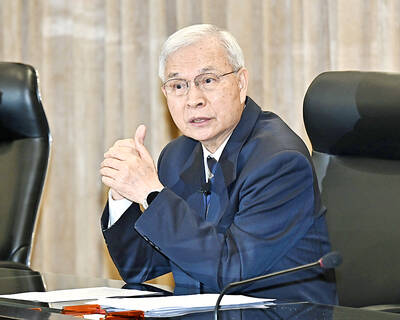A small number of the newly developed Hsiung Feng II-E cruise missiles have already been deployed around the nation, and up to 100 of the missiles will be manufactured within the next eight years, military sources said.
The missiles will be deployed in Taiwan proper as well as on its outlying islands, they said.
The locally developed Hsiung Feng II-E has a range of up to 1,000km and can be launched from land, sea or air. The range depends upon the type of engine used.
The missile had been slated to be a part of this year's National Day military display, but was pulled from the display after the US expressed strong concern.
Sources said that future production of the Hsiung Feng would be divided into two phases. The first phase will utilize turbo jet engines, giving the missiles a range of about 500km, although these missiles will be referred to by the military as belonging to the 600km class.
The second stage of the project will utilize more efficient turbo fan engines being developed by the Ministry of National Defense-affiliated Chungshan Institute of Science and Technology. In addition to increasing the range of the missiles, the engine is also expected to increase their accuracy.
However, the sources said that the whole Hsiung Feng mass production project could be put in jeopardy if the institute failed to develop a suitable turbo fan engine.
They said that while many key components needed for weapons production originate from the US, the number of components approved for export by Washington has dwindled in the past six months.
This has affected the nation's Hsiung Feng II, Hsiung Feng III and Hsiung Feng II-E missiles, as well as other advanced weapons, they said.
The Chungshan Institute is seeking to remedy the situation by working on developing weapons components domestically as well as seeking non-US sources of components from abroad, sources said.
Researchers have so far been cautiously optimistic, but it remains to be seen whether or not US components can be successfully replaced, the sources said.

The CIA has a message for Chinese government officials worried about their place in Chinese President Xi Jinping’s (習近平) government: Come work with us. The agency released two Mandarin-language videos on social media on Thursday inviting disgruntled officials to contact the CIA. The recruitment videos posted on YouTube and X racked up more than 5 million views combined in their first day. The outreach comes as CIA Director John Ratcliffe has vowed to boost the agency’s use of intelligence from human sources and its focus on China, which has recently targeted US officials with its own espionage operations. The videos are “aimed at

STEADFAST FRIEND: The bills encourage increased Taiwan-US engagement and address China’s distortion of UN Resolution 2758 to isolate Taiwan internationally The Presidential Office yesterday thanked the US House of Representatives for unanimously passing two Taiwan-related bills highlighting its solid support for Taiwan’s democracy and global participation, and for deepening bilateral relations. One of the bills, the Taiwan Assurance Implementation Act, requires the US Department of State to periodically review its guidelines for engagement with Taiwan, and report to the US Congress on the guidelines and plans to lift self-imposed limitations on US-Taiwan engagement. The other bill is the Taiwan International Solidarity Act, which clarifies that UN Resolution 2758 does not address the issue of the representation of Taiwan or its people in

US Indo-Pacific Commander Admiral Samuel Paparo on Friday expressed concern over the rate at which China is diversifying its military exercises, the Financial Times (FT) reported on Saturday. “The rates of change on the depth and breadth of their exercises is the one non-linear effect that I’ve seen in the last year that wakes me up at night or keeps me up at night,” Paparo was quoted by FT as saying while attending the annual Sedona Forum at the McCain Institute in Arizona. Paparo also expressed concern over the speed with which China was expanding its military. While the US

SHIFT: Taiwan’s better-than-expected first-quarter GDP and signs of weakness in the US have driven global capital back to emerging markets, the central bank head said The central bank yesterday blamed market speculation for the steep rise in the local currency, and urged exporters and financial institutions to stay calm and stop panic sell-offs to avoid hurting their own profitability. The nation’s top monetary policymaker said that it would step in, if necessary, to maintain order and stability in the foreign exchange market. The remarks came as the NT dollar yesterday closed up NT$0.919 to NT$30.145 against the US dollar in Taipei trading, after rising as high as NT$29.59 in intraday trading. The local currency has surged 5.85 percent against the greenback over the past two sessions, central